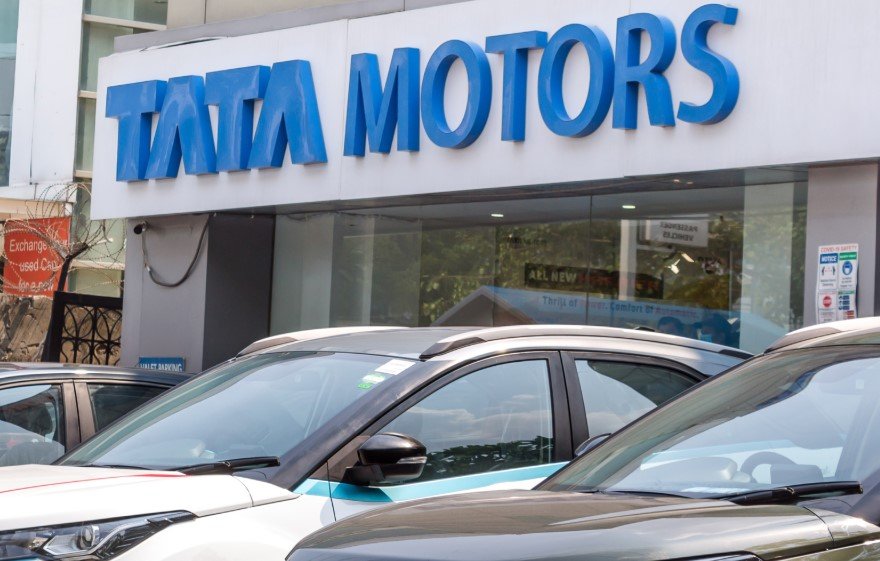Tata Motors’ first-quarter results landed with a thud on the earnings sheet but not in the stock market. Even as net profit slid nearly a third, the stock edged higher on Monday morning, leaving traders wondering if the rally is a sign of resilience or just a temporary blip.
A Surprise Green Day for the Stock
The numbers, at first glance, weren’t exactly the kind of thing that sends investors into a buying frenzy. Net profit for April–June came in at ₹3,924 crore, a steep 30% decline compared to the ₹5,643 crore booked a year ago. Revenues slid 2.5% year-on-year to ₹1.04 lakh crore, hurt by weaker sales across all businesses.
And yet, by mid-morning on August 11, the stock was up over 2% at ₹649, after briefly touching a high of ₹653.35 on the NSE.
Some traders see the move as a relief rally — the results were bad, but not as bad as feared. Others suspect it’s a case of large funds taking advantage of recent weakness to build positions before an eventual turnaround.
Jaguar Land Rover’s Tough Quarter
The drag on the quarter was clear: Jaguar Land Rover. The UK-based luxury brand, owned by Tata Motors since 2008, saw revenue fall more than 9% to £6.6 billion. Its EBIT margin, a key profitability gauge, fell 490 basis points to just 4%.
Tata Motors attributed much of the pain to Donald Trump’s newly imposed tariffs on certain imported vehicles, which pinched demand in key markets. The luxury SUV segment — a JLR mainstay — has been especially exposed to U.S. trade policy shifts.
One analyst at a Mumbai-based brokerage put it bluntly: “JLR is bleeding margin. The core India business is steady, but the luxury arm is facing a perfect storm of tariffs, currency volatility, and softening demand in Europe.”

Domestic Operations: Slower but Still Moving
Closer to home, the picture wasn’t much brighter. Tata Motors reported volume declines in its passenger and commercial vehicle segments. Domestic sales have been pressured by softer rural demand and slower government spending on infrastructure in recent months.
Still, there’s been a silver lining in certain categories. The company’s electric vehicle portfolio — led by the Nexon EV — is holding market share despite growing competition. Fleet orders for electric buses also helped offset some of the volume loss in trucks.
A quick snapshot of key numbers from Q1 FY26 compared with Q1 FY25:
| Metric | Q1 FY26 | Q1 FY25 | Change |
|---|---|---|---|
| Net Profit | ₹3,924 crore | ₹5,643 crore | -30% |
| Revenue from Operations | ₹1.04 lakh crore | ₹1.07 lakh crore | -2.5% |
| JLR Revenue | £6.6 billion | £7.26 billion | -9% |
| JLR EBIT Margin | 4% | 8.9% | -490 bps |
Why the Stock is Still Up
If the financials were weak, why did the stock rise? Market chatter points to three factors.
-
Earnings expectations were already low: Analysts had braced for a sharp profit fall given the tariff hit and weak JLR sales.
-
Management tone was cautiously optimistic: Despite the slump, Tata Motors guided for an improvement in the second half of FY26.
-
Broader market mood: Indian equities have been buoyant in recent weeks, lifting auto stocks in particular.
In short, the earnings didn’t shock anyone, and the market’s risk-on mood did the rest.
Global Headwinds Cloud the Outlook
The next few quarters could be a test of patience for investors. Global trade tensions aren’t easing, and JLR remains heavily reliant on exports to the U.S. and Europe. Any prolonged slump in these markets could keep pressure on margins.
There’s also the currency factor — the British pound’s weakness against the U.S. dollar has raised input costs for certain JLR components sourced from abroad. And with Europe’s EV market getting more competitive, pricing power may erode further.
One Mumbai fund manager summed it up in a phone call: “The market is giving Tata Motors the benefit of the doubt. But if JLR doesn’t recover in two quarters, the stock could give back these gains quickly.”
What Analysts Are Saying
Brokerage recommendations are mixed. Some houses have trimmed their earnings estimates but maintained a positive stance on the long-term story, pointing to Tata Motors’ EV strategy and cost discipline. Others warn that the stock may be fully priced for now.
In research notes issued Monday morning:
-
A leading domestic brokerage maintained a “Hold” rating with a price target of ₹660, citing near-term headwinds.
-
An international bank kept its “Buy” call but cut FY26 EPS estimates by 8%.
-
Another firm downgraded the stock to “Sell” citing deteriorating margins at JLR.
Interestingly, none of them see the Q1 drop as a sign of structural decline — more a cyclical setback.
Should Investors Buy, Sell, or Hold?
The million-rupee question is what to do now. For short-term traders, the recent bounce could be an opportunity to lock in quick gains, especially if broader market sentiment turns risk-averse.
For long-term investors, it depends on conviction in Tata Motors’ turnaround plan for JLR and its domestic EV play. If you believe the luxury brand can regain margin footing and tariffs will ease, current levels may look attractive.
But as one veteran trader put it, “You don’t bet the farm on a stock with this kind of global exposure. You scale in, keep dry powder, and wait for the next bad headline — because it’s coming.”
